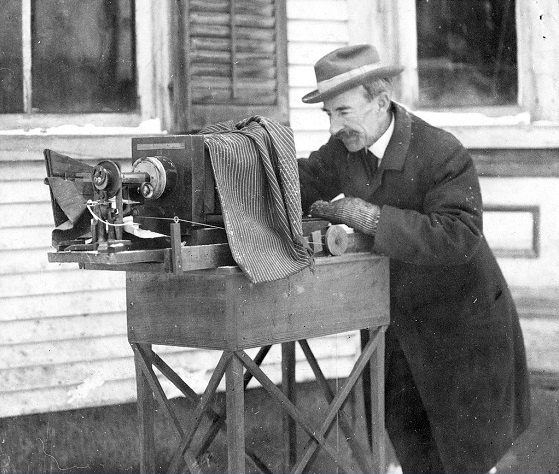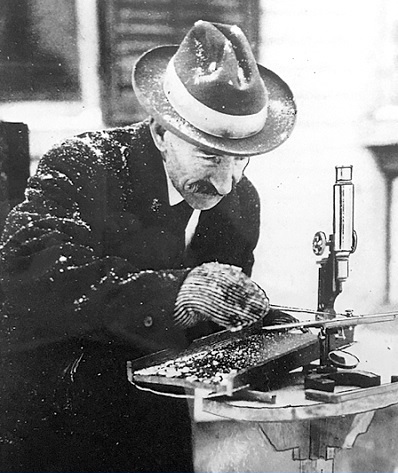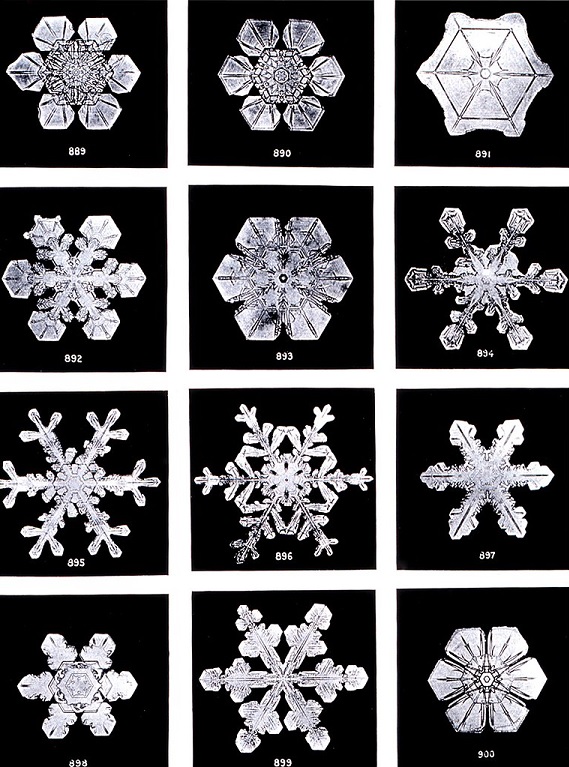Share on:
Wilson A. Bentley
Wilson Alwyn Bentley, also known as Snowflake Bentley, was an American meteorologist and photographer, born February 9, 1865 in the small village of Jericho in northern Vermont. He was the first known person to take detailed photographs of snowflakes and record their features. He perfected a process of catching flakes on black velvet in such a way that their images could be captured before they either melted or sublimated.

The Bentley homestead was in a valley on the east end of Jericho snuggled up at the base of Bolton Mountain. The country winters were long and hard, and in those days attendance at the one-room schoolhouse was very infrequent. Perhaps it was because of this, that Bentley obtained his lifelong passion to study and understand water in all of its forms-dew, frost, clouds, rain, and especially snow in the form of ice crystals.
During the next two years young Bentley spent many a winter's day in a cold room at the rear of the farmhouse, peering through the microscope at ice crystals collected from the passing storms. He was fascinated by the beauty and intricacy of the crystals, and attempted to capture this by making drawings of them. He made hundreds of sketches but was painfully aware that what he drew was a poor substitute for what he saw. One day he chanced to read about cameras that could take photographs through a microscope.
For over a year Bentley experimented with the microscope, the camera, and the dry plates of that day that were used to record the photographic image. He knew nothing about photography and failure followed upon failure. But through persistence and learning by trial and error he slowly approached his goal. And then, during a snowstorm on 15 January 1885, he obtained the first photomicrographs ever taken of an ice crystal.

Blentley stated: «The day that I developed the first negative made by this method, and found it good, I felt almost like falling on my knees beside that apparatus and worshipping it! It was the greatest moment of my life.»
For 13 years Bentley worked quietly and obtained over 400 photomicrographs of ice crystals. He kept detailed meteorological records, and pondered over the meaning of the shapes and sizes of the crystals and why they often varied from one storm to the next. The outside world had yet to hear from him.
Interestingly enough it was a university professor, George Perkins of the University of Vermont, who heard of Bentley's work and convinced him that he did indeed have something worthwhile to tell the outside world. His first article was published in 1898 in Appleton's Popular Scientific Monthly.
His analysis of his data convinced him, among other things, that different segments of a storm produced their own predominant type of ice crystal, that the form of the crystal was a function of the air temperature, that the circulation within the storm could be deduced from the crystal structure, and that the change in form often noted in a single crystal reflected the changes in the temperature of the air through which the crystal fell on its journey to the ground.
By 1920 Bentley was known to thousands, not by name but as the Snowflake Man. The best of his photomicrographs were in demand by jewelers, engravers, and by the textile industry.
In November 1931 he published the book "Snow Crystals". The bulk of the book was a magnificent collection nearly 2,500 photomicrographs. Most of the pictures were of various forms of the ice crystal; about 100 were of frost and dew.

He came to the conclusion that no two snowflakes are the same, in his own words: «Under the microscope, I found that snowflakes were miracles of beauty; and it seemed a shame that this beauty should not be seen and appreciated by others. Every crystal was a masterpiece of design, and no one design was ever repeated. When a snowflake melted, that design was forever lost. Just that much beauty was gone, without leaving any record behind.»
Wilson Bentley died of pneumonia in the afternoon of December 23, 1931. His work was acquired by various universities around the world, as well as being published in various scientific journals, such as the Monthly Weather Review.
He captured more than 5,000 images of crystals in his lifetime. Each crystal was caught on a blackboard and transferred rapidly to a microscope slide. Even at subzero temperatures, snowflakes are ephemeral because they sublimate.
🥇 Find out more:
✅ The 7 most common types of snowflakes
✅ Why is snow white when ice is transparent?

